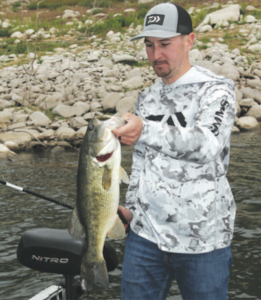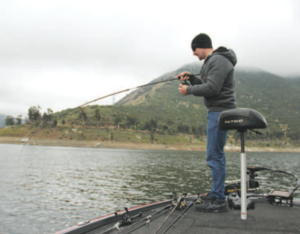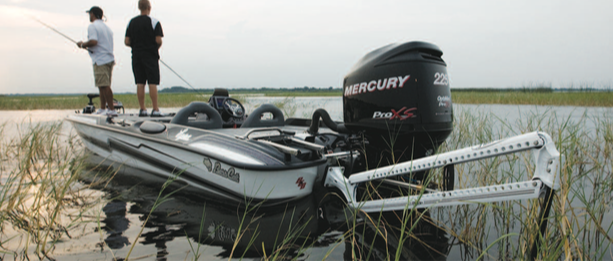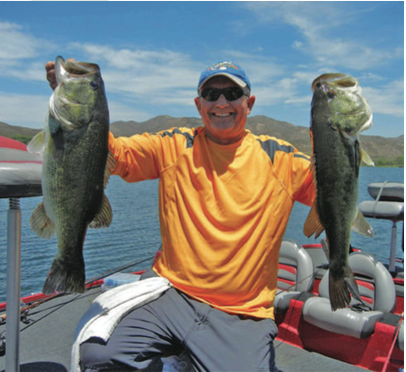BY GEORGE KRAMER
Maybe you file it under unintended consequences, or maybe evolution, but a funny thing happened the other day at the lake. As I made a midday run from the far end back down to the dam, déjà vu hit me like concrete block.
Skirting past windy points, river ledges and known outside rockpiles, there was a boat parked on every spot. But unlike the 1970’s when I first encountered this phenomenon, there were no anchor ropes stretching from bow and stern—in fact, no rode at all. Every place where tumbling rockslides suggested bass-holding structure, there was a boat (as we used to say) camped and quite unlikely to move.

It was a sight to see. And made even more poignant when I looked in my file to find a Pdf of a feature I did on “double anchoring” way back in 1976. It was a how-to treatise on what was common practice from San Diego to Ventura. You set up on a spot with the intention of staying put.
And I remember, even before owning my first 12- and then 15-foot boat, I spent many a Saturday hunkered down for four to as long as seven hours on one spot. Sure, there was in play a combination of live bait and “stitched” plastic worms with a split shot maybe five or six inches ahead of the worm. However, without that stable platform, it was extremely hard to control your presentation.
Later, many recall the same type of anchoring approach at Lake Castaic in the 1980’s. There crawdad fishermen were on the cusp of breaking the world record. The one thing that differed in my eyes is those big fish chasers moved around more — changing spots and areas.
Under the influence of tournament fishing, however, the big bait fishermen showed that moving and casting those nine to 13-inch creations further pushed anchoring into obscurity. And for a time, also dominated the local, trout-planted reservoir bass tournaments. But real big bass guys can document those successes. I’m looking at the greater issue of boat positioning in this article.

Better, longer-shafted, higher powered trolling motors in the 1990’s, meant the absolute end to stationary fishing. Some decried the passing over of good water, or failing to dissect proven structure, but the mindset of the sport was “Go find the fish, don’t wait for the fish to come to you.”
I might be historically inaccurate here, but it seems to me that the Power-Pole concept, especially in water shallow enough for the arms to touch bottom, became an innovative and even “cool” way to slow down and probe certain areas. Southern California is not a place you’ll find massive, shallow grass beds that can be fished from a set position. But plenty of other places across the country are ideal.
Of course, such a tool can be used in more steep-sided reservoirs for making specific presentations, but they are more of a luxury than a necessity for many bass anglers — even serious ones.
With the advent of sonar/GPS and “rudimentary” trolling motor linkage in the same general era, there were all kinds of possibilities projected. Yet, no one was sure what would stick and what would just go away. It was thought that combining GPS mapping to one’s trolling motor would allow the electric motor to hold you or guide you along a contour.
But more than genius, it might have been sheer convenience that brought the “spot lock” concept into play. All it took was a few guys trying to tie knots in the wind, only to be blown a hundred yards down the lake. When they discovered the method that would run the trolling motor at just the speed and direction to keep the boat in a precise location so that you could re-rig one or several outfits — it caught on like nothing else.
And instead of one’s partner fighting the trolling motor in the wind, he/she could stand in any place in the boat and cast away while you were tying double uni’s with a twist of lime. Sure, there was an extra draw on the batteries, but even those have improved dramatically, making the new technology almost essential to the buying public.
And now the game, which started dead slow, continually sped up, and now has slowed down again, has turned so many competitors into “dock fishermen.” On the other hand, it may also show that precision has again become a crucial element in catching bass. Just like it was 50 years ago!
TRANSITIONS?
Say what you want, in the last decade I don’t sense the same reliable, seasonal conditions spread out over the course of a year. When it’s cold in November through February, we say it’s winter, but when did late summer become fall on its way to a chilly New Year? And when did the cold subside sufficiently for us to call it spring — the favored time of many bass anglers?
In Northern California, they would argue this point, but from a fish behavior standpoint, the views of the late “Lunker Bill” Murphy have stuck with me and really helped me stay on the fish. He voiced the opinion that really there are only two seasons: summer and winter. The spawning period was merely a disruption in summer. And winter was just a short season leading back up to summer.
True, ethically he was fiercely opposed to bed fishing, but he also never felt he needed to. He would set and reset lake records by staying outside in the deeper summer haunts of the larger fish. And some of his ideas are being given more credence with the advent of live action, forward looking, real-time sonar units. Instead of the behavior transitions we used to refer to, technology-aided bass fishermen today aren’t seeing fish as doing one thing and then slowly changing with the calendar. They see fish in their real-time mood and cast directly to them—the heck with where they are in their life cycle. If they bite, it doesn’t matter.
Of course, when “seasonal” conditions call for long johns one day and shorts the next, it’s easy to be confused. The good thing is, rarely are the bass bothered by our comfort needs—so keep casting.




